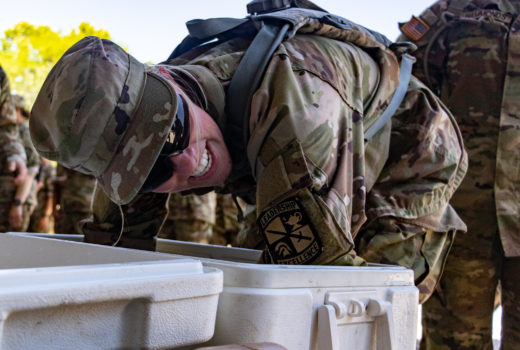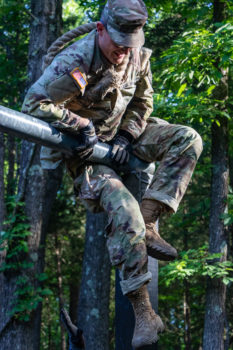‘Slow is smooth and smooth is fast’, is the common mantra heard at the Field Leader Reaction Course (FLRC) during the first Cadet run-through of the summer. On June 3, 2022, 1st Regiment Cadets from the Charlie and Delta companies rotated by squad through 16 creative obstacles that challenge the Cadets’ problem solving and leadership skills. The courses require planning and a quick execution. They have five minutes to plan and 15 minutes to complete each one. Before they start, the cadre brief the Cadets by reading the mission details and limitations. Once time has run out they debrief to see what they did well and what they can work on.

According to 2nd Lt. Bradley Barlow, FLRC cadre, this is not a must pass or even a must attempt training, it is for team building. “This is a fun break from their training,” said Barlow. Most of the summer, the Cadets will go through training under more stressful circumstances, so this is a chance for them to get used to each other’s leadership styles in a less stressful environment according to U.S. Army Cadet Daneilia McTaggart from Kennesaw State University, Georgia Institute of Technology ROTC program. Often the Cadets do things as a whole platoon, so the opportunity to work with smaller numbers can lessen the overwhelming feeling of so many voices, “my favorite part was working with my individual squad,” said McTaggart.

During the FLRC training she learned that there are multiple ways to get the job done, “We had a lot of great ideas that popped up and all of them could have worked, but choosing the one that’s most efficient, and that will get the job done fastest, since we have a 15 minutes window, is probably the best,” she said.
With so many voices, there often ends up being “too many cooks in the kitchen” said Barlow, which is the part that McTaggart found to be the most difficult. She said, “I think the most challenging part is pretty much blending all the different ideas, trying to find the plan that works, that’s the team’s plan and not just your plan.” She said this is what she kept in mind while getting the job done, that and having fun.




